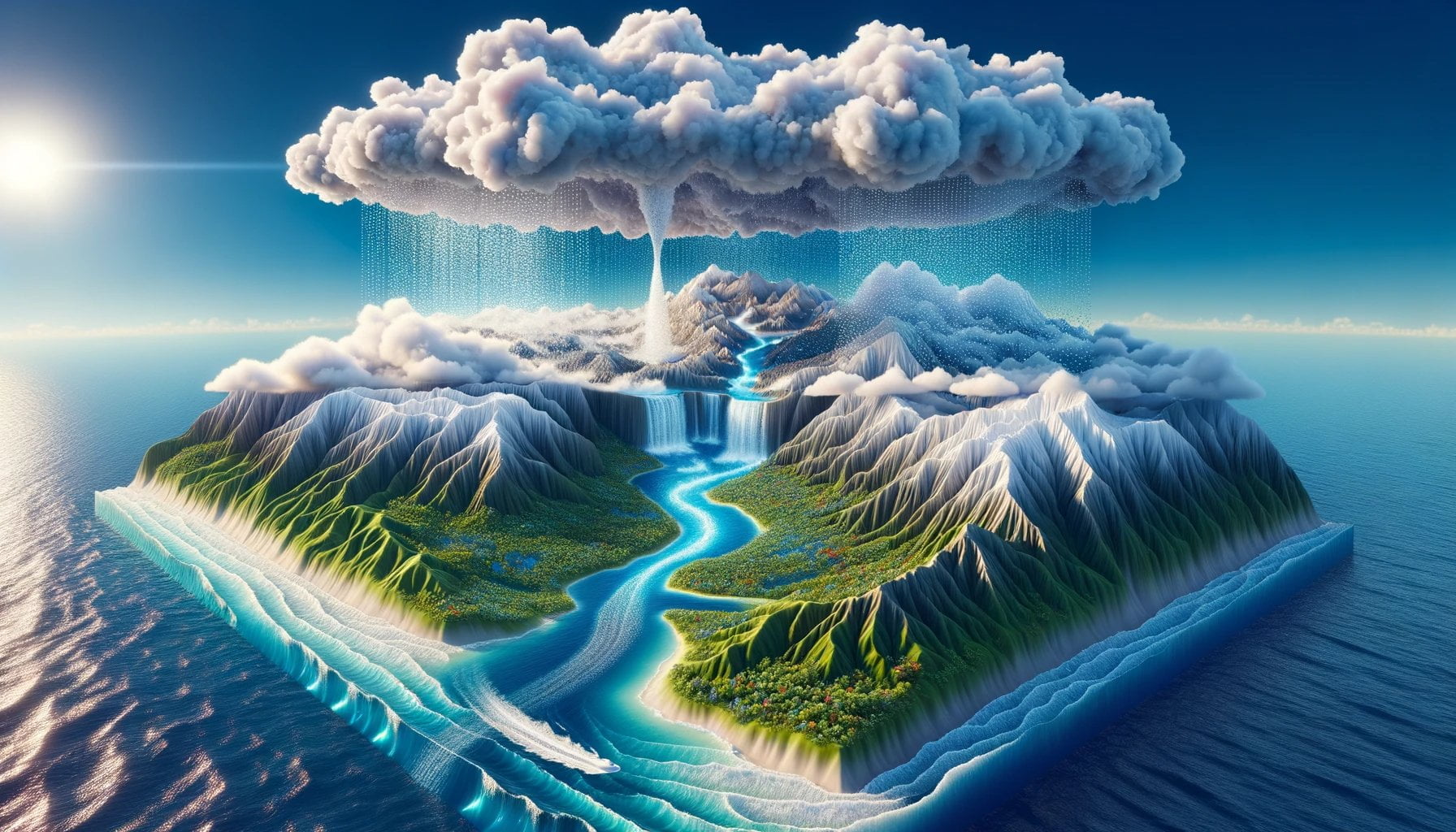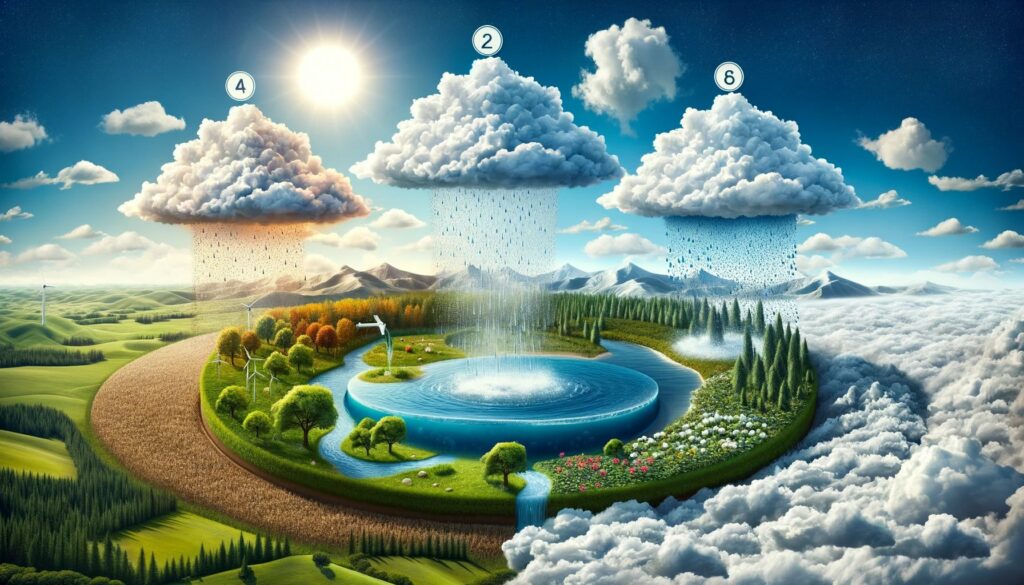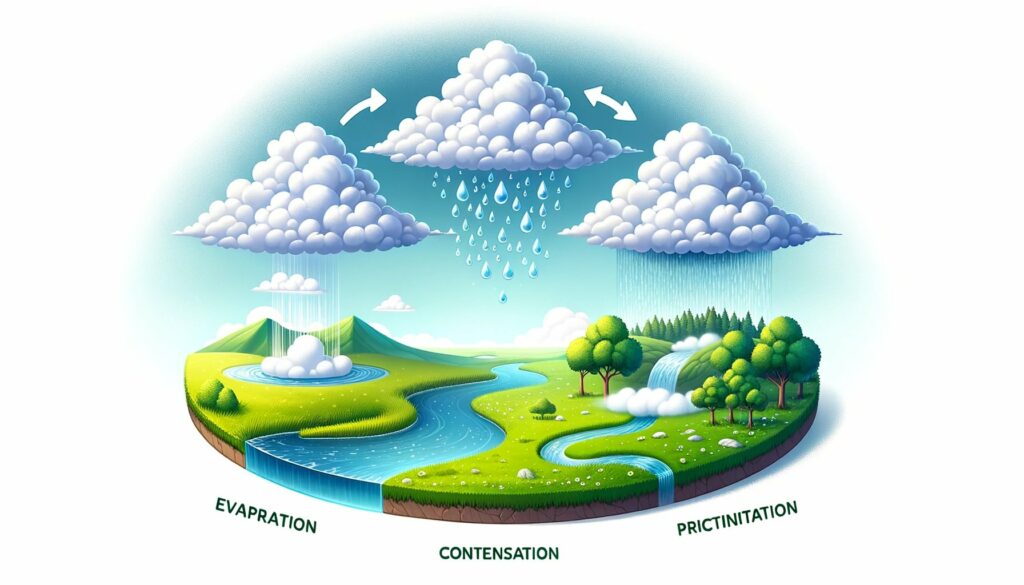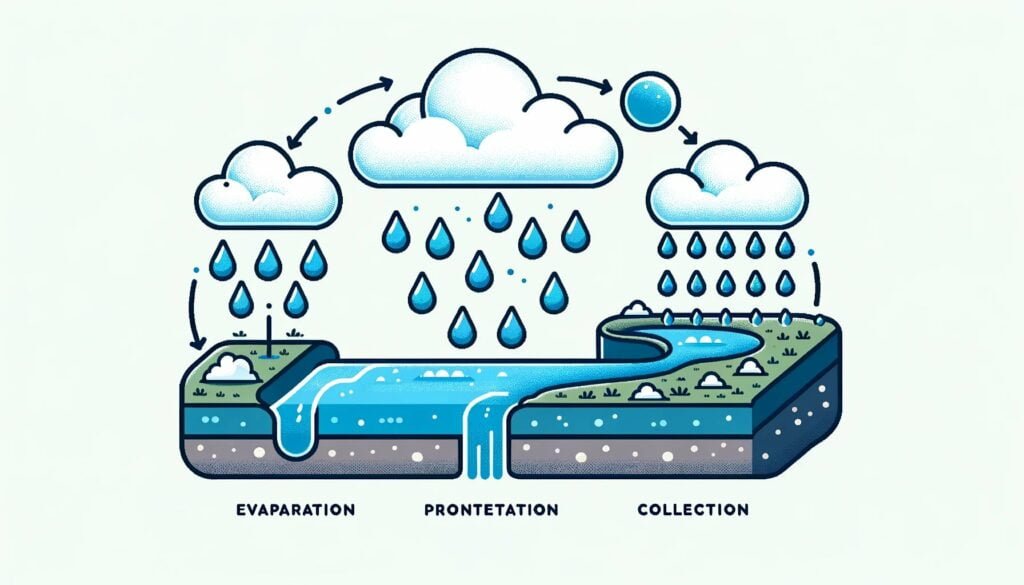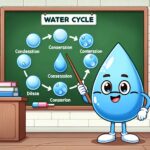In the fascinating world of meteorology, the precipitation cycle is an awe-inspiring phenomenon that encompasses a mesmerizing interplay of four crucial steps. Commonly known as evaporation, condensation, cloud formation, and precipitation, these distinct processes come together to create the weather patterns we observe. In this article, aptly titled “The 4 Steps of the Precipitation Cycle: Explained,” we delve into the intricacies of this perpetual cycle, unraveling the mysteries behind each stage. Whether you’re a curious observer or an aspiring meteorologist, join us as we embark on a journey to understand the inner workings of this captivating natural process.
What are the 4 Steps of the Precipitation Cycle?
Water is a fundamental ingredient for life on Earth, and its continuous circulation is made possible through a process known as the precipitation cycle. This intricate cycle consists of four essential steps that work together seamlessly to ensure the movement and distribution of water across the planet. In this article, we will delve into the captivating world of the precipitation cycle and explore the four major steps that drive this awe-inspiring phenomenon.
Evaporation: Transforming Liquid to Gas
The first step in the precipitation cycle is evaporation. When the sun’s radiant energy reaches the Earth’s surface, it heats up the bodies of water, including oceans, lakes, and rivers. This process causes the water molecules at the surface to gain energy and transform from a liquid state to a gaseous state, forming water vapor. Once in the atmosphere, this water vapor rises and mixes with the air, becoming an integral part of the atmosphere.
Condensation: From Vapor to Clouds
As the water vapor rises higher into the atmosphere, it encounters cooler temperatures at higher altitudes. This cooling effect causes the water vapor to condense back into tiny droplets or ice crystals, forming clouds. In the process of condensation, the gaseous water vapor transitions back into its liquid or solid form, creating visible masses of moisture in the sky. These clouds vary in size, shape, and altitude, and play a crucial role in determining weather conditions.
Precipitation: Falling from the Skies
When clouds become saturated with water droplets or ice crystals and can no longer hold them, precipitation occurs. Precipitation refers to the process in which the condensed water droplets or ice crystals within the clouds grow larger and heavier until they fall back to the Earth’s surface. This can take the form of rain, snow, sleet, or hail, depending on the atmospheric conditions. Precipitation is nature’s way of replenishing the Earth’s water sources and maintaining the delicate balance of ecosystems.
Collection: Gathering Water on Land
The final step in the precipitation cycle is collection. After precipitation falls to the ground, it accumulates on the Earth’s surface, filling up bodies of water such as rivers, lakes, and oceans. From here, the collected water can follow various paths, such as being absorbed by plants and trees, seeping into the ground to replenish underground water reservoirs, or flowing into larger bodies of water through tributaries and streams. This collected water serves as the starting point for future evaporation, continuing the endless cycle of precipitation.
The precipitation cycle is not only essential for water circulation but also plays a significant role in shaping climate patterns around the world. By distributing water and regulating temperature, the precipitation cycle influences the formation of weather systems, the growth of vegetation, and the overall climate conditions in different regions.
Measuring precipitation accurately is vital for monitoring weather patterns, studying climate change, and managing water resources efficiently. Scientists and meteorologists employ various methods to measure precipitation, including rain gauges, weather radars, and satellite technologies. These tools enable us to gather data on precipitation rates, patterns, and intensities, aiding in our understanding of the water cycle and its impacts on our planet.
In conclusion, the precipitation cycle encompasses four crucial steps: evaporation, condensation, precipitation, and collection. Through this unending process, water continuously circulates, providing a lifeline to all living organisms on Earth. By exploring and comprehending the intricacies of the precipitation cycle, we gain valuable insights into the profound mechanisms that shape our weather and sustain our ecosystems. So the next time you witness rain or snowfall, take a moment to appreciate the beauty and complexity of the precipitation cycle and its profound impact on our world.
Precipitation is a vital component of the water cycle. It refers to any form of water that falls from the atmosphere and reaches the Earth’s surface. From rain and snow to hail and sleet, precipitation plays a crucial role in replenishing our water resources. Understanding the precipitation water cycle is key to comprehending the intricate processes that sustain life on our planet.
To dive deeper into the fascinating world of precipitation and its correlation with the water cycle, click here. This link will take you to a comprehensive resource that explores the various stages and mechanisms involved in precipitation formation. Discover the science behind how clouds form, what triggers rainfall or snowfall, and how precipitation ultimately recharges our rivers, lakes, and underground aquifers.
Become a precipitation aficionado and unlock the mysteries of the water cycle by clicking the link now. Don’t miss out on the chance to unravel the secrets of this essential natural phenomenon. Happy exploring!
Cloud Formation: The Gathering and Growth of Water Droplets in the Atmosphere
Cloud formation is an essential part of the precipitation cycle, as it plays a crucial role in the gathering and growth of water droplets in the atmosphere. Understanding this process is key to comprehending the overall mechanism of how water moves and distributes itself across the planet. In this article, we will explore the four fundamental steps involved in the precipitation cycle, diving into the intricacies of evaporation, condensation, cloud formation, and precipitation.
Evaporation: Transforming Liquid into Vapor
The first step in the precipitation cycle is evaporation. This process occurs when the sun’s energy heats up bodies of water, causing water molecules to transform from a liquid state into water vapor. As the water vapor rises into the atmosphere, it forms invisible gas and becomes part of the air we breathe. Imagine a pot of water boiling on a stove, with the steam rising and dissipating into the air. Evaporation is like that, except on a much larger scale.
Condensation: From Vapor to Visible Water Droplets
As the water vapor continues to rise into higher altitudes, it encounters cooler temperatures, which leads to the second step of the precipitation cycle: condensation. The colder temperatures cause the water vapor to lose energy, causing it to condense back into tiny droplets or ice crystals, forming what we know as clouds. These clouds may appear fluffy or wispy, hovering in the sky above us. Think of it as the water vapor transforming back into visible water droplets – like the steam from a boiling pot of water condensing onto a cold surface.
Cloud Formation: The Birth of Atmospheric Marvels
Now, let’s dive deeper into cloud formation – that fascinating process where water droplets or ice crystals gather and grow. Clouds are formed when water vapor in the air collects with other materials, such as dust or pollution, coming together to create visible masses of condensed water droplets. These droplets can vary in size and density, shaping the appearance and characteristics of different types of clouds. It’s like a collective dance of water and other particles, forming mesmerizing shapes that captivate our gaze.
[Cloud formation: The gathering and growth of water droplets in the atmosphere] is a captivating phenomenon that constantly occurs around us, giving atmospheric scientists like myself ample opportunities for observation and study.
Precipitation: When Clouds Release Their Watery Bounty
The last step in the precipitation cycle is precipitation itself. When droplets in the clouds become too heavy for the air to hold, they begin to fall back to the Earth’s surface. This is when we experience rain, snow, sleet, or hail. The specific type of precipitation depends on the temperature conditions present at different elevations. It’s like nature’s way of answering the call of gravity, with clouds releasing their watery bounty.
Remember those mesmerizing clouds we talked about in the previous step? Well, they eventually become too full of water vapor, and that’s when precipitation occurs. It’s like a heavy, dark cloud carrying a bucket of water that needs to be poured back onto the ground.
Conclusion
Understanding the intricate mechanisms of the precipitation cycle, particularly cloud formation, provides us with a deeper appreciation for the wonders of the weather. Evaporation, condensation, cloud formation, and precipitation work together in a harmonious cycle, ensuring the movement and distribution of water across the planet. From the gathering and growth of water droplets in the atmosphere to the transformative powers of clouds, the precipitation cycle holds many mysteries waiting to be uncovered.
So, the next time you look up at the sky and see those beautiful clouds, remember the incredible journey their water droplets have taken – from evaporation to condensation, and finally, to their release as captivating precipitation. The precipitation cycle is a magnificent process, and by understanding its four steps, you can unlock the secrets of the atmosphere and appreciate the magic happening above us every day.
Precipitation: The release of water from the atmosphere in the form of rain, snow, or other forms
The precipitation cycle, also known as the water cycle or hydrologic cycle, is a continuous process that ensures the movement and distribution of water across the planet. It plays a crucial role in shaping climate patterns, weather systems, vegetation growth, and overall climate conditions globally. Understanding the four major steps of the precipitation cycle – evaporation, condensation, precipitation, and collection – allows us to appreciate the wonders of weather and the movement of water across the Earth.
Evaporation: Transforming Liquid Water into Water Vapor
Evaporation is the first step in the precipitation cycle, where liquid water on the surface of the Earth turns into water vapor and rises into the atmosphere. It takes place when the sun’s energy heats up bodies of water like oceans, lakes, and rivers, causing water molecules to gain enough energy to break free from the liquid state. As these water molecules escape into the air, they form water vapor.
Condensation: Transforming Water Vapor into Clouds
Once water vapor enters the atmosphere, condensation occurs. This step involves the cooling down of water vapor at higher altitudes, causing it to change back into tiny droplets or ice crystals. These minute particles combine together, forming clouds. Just like how you can see your breath on a cold day, the cooling temperatures lead to the formation of visible water droplets or ice crystals in the atmosphere.
Cloud Formation: Gathering and Growth of Water Droplets
Cloud formation is a crucial step in the precipitation cycle. Clouds act as reservoirs for water, providing a place for the water droplets or ice crystals to gather and grow. As the water droplets or ice crystals combine with other materials in the air, such as dust or pollution, they increase in size. This process is similar to how a snowball grows larger when rolled through the snow. The larger the droplets or ice crystals become, the heavier the clouds become.
Precipitation: The Release of Water from the Atmosphere
When the clouds become too heavy with water droplets or ice crystals, precipitation occurs. Precipitation is the release of water from the clouds back to the Earth’s surface in the form of rain, snow, sleet, or hail. Just like the weight of a full water balloon causing it to burst, the weight of the water in the clouds overcomes the ability of the clouds to hold the water. It then falls under gravity’s pull, returning to the Earth’s surface.
Collection: Accumulating Water on the Earth’s Surface
The final step of the precipitation cycle is collection. This step involves the water that has fallen on the surface of the Earth. The collected water can evaporate again, continuing the cycle. It accumulates in various bodies of water, such as rivers, lakes, and oceans, serving as the starting point for future evaporation. These bodies of water act as natural reservoirs, providing a continuous supply of water for the precipitation cycle.
Conclusion
In summary, the precipitation cycle consists of four steps: evaporation, condensation, cloud formation, and precipitation. This continuous process ensures the movement and distribution of water from the Earth’s surface to the atmosphere and back again. From the evaporation of water from the surface to the release of water as rain, snow, or other forms, each step plays a vital role in maintaining the Earth’s water balance and supporting various ecosystems. Understanding the intricacies of the precipitation cycle allows us to appreciate the beauty and importance of weather and the unending movement of water across our planet.
FAQ
Question 1
What are the four steps of the precipitation cycle?
Answer 1
The four steps of the precipitation cycle are evaporation, condensation, precipitation, and collection.
Question 2
What is evaporation in the precipitation cycle?
Answer 2
Evaporation is the process in which water on the surface of the earth turns into water vapor and rises into the atmosphere.
Question 3
How does condensation occur in the precipitation cycle?
Answer 3
Condensation occurs when water vapor in the air cools down and changes back into tiny drops of liquid water, forming clouds.
Question 4
What is precipitation in the precipitation cycle?
Answer 4
Precipitation happens when the clouds become heavy with water and the water falls back to the ground in the form of rain or snow.
Question 5
What is the collection step in the precipitation cycle?
Answer 5
The collection step involves the water that has fallen on the surface of the earth, which can then evaporate again and continue the cycle.
- Sept 31 Myth: Unveiling Calendar Secrets - March 18, 2025
- How Long & Till December 18, 2025: Accurate Countdown Guide - March 18, 2025
- Discover Japanese Artists: A Complete History - March 18, 2025
